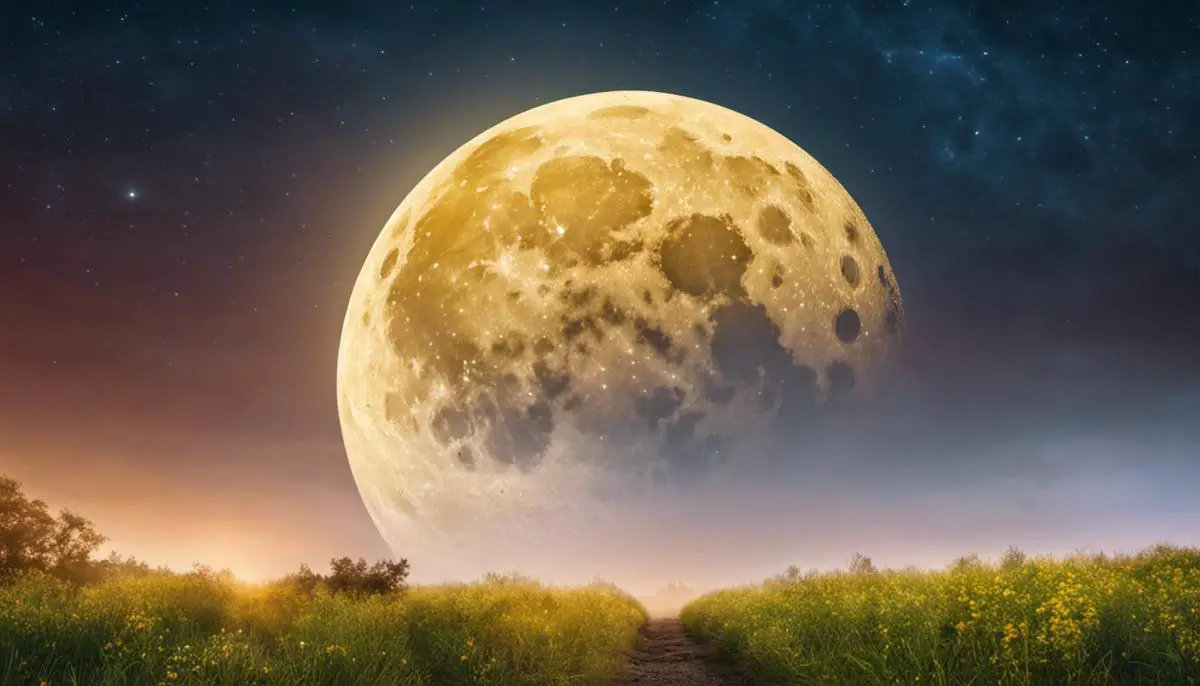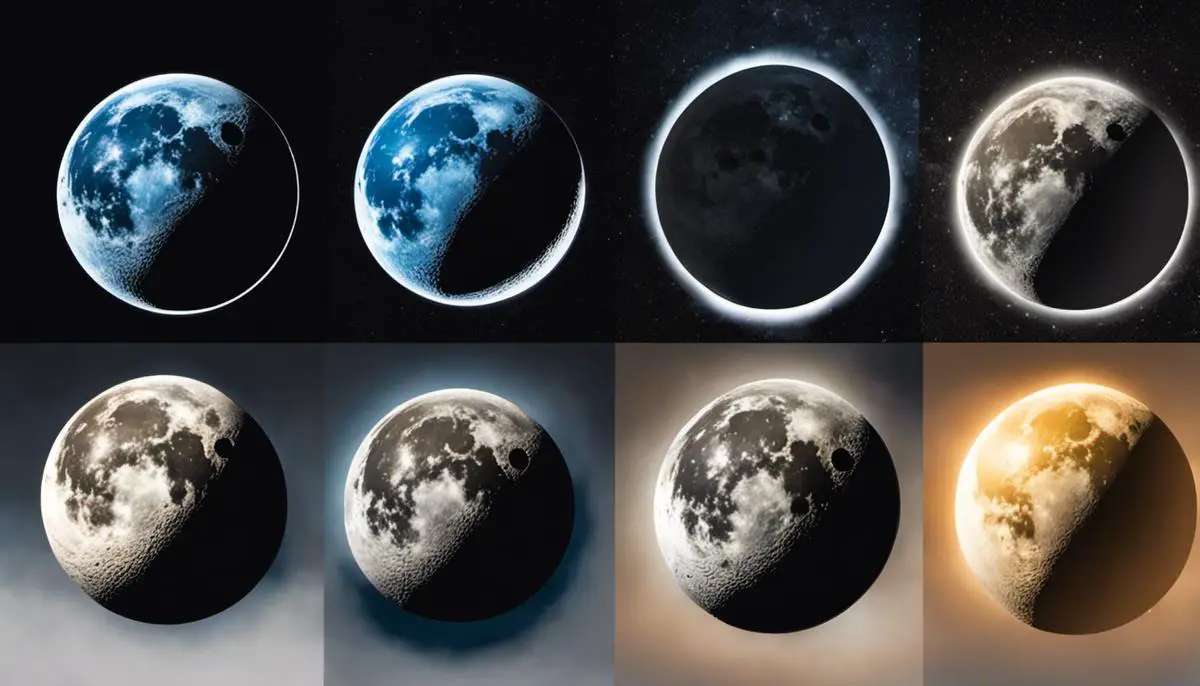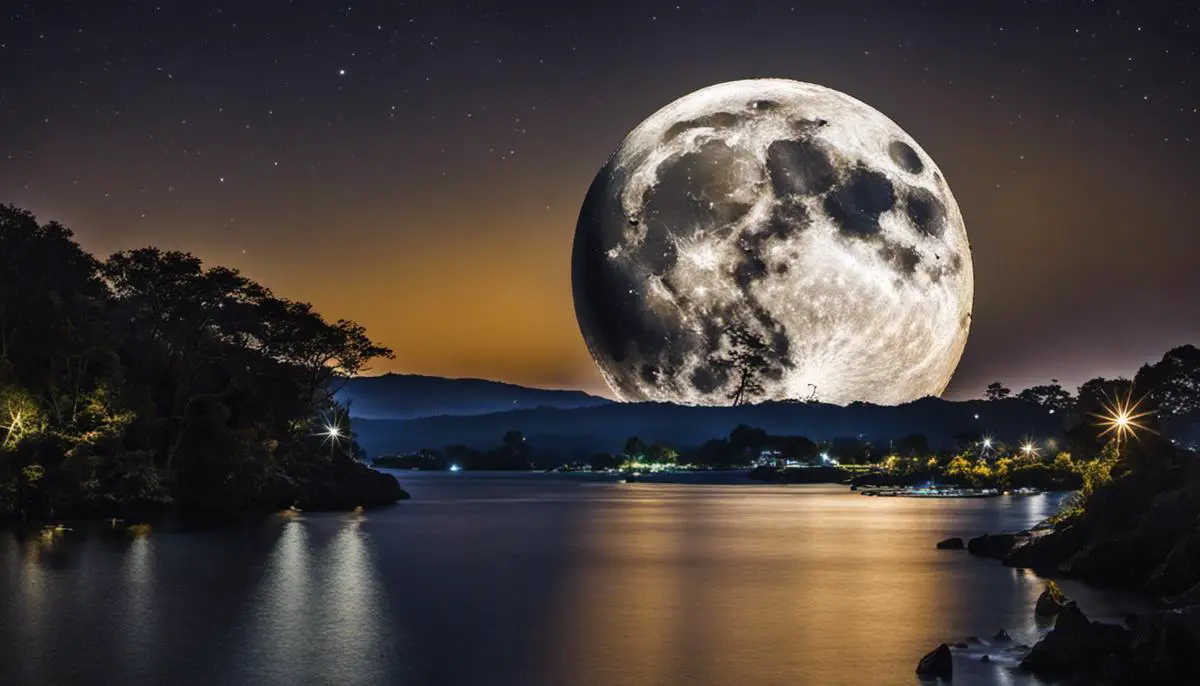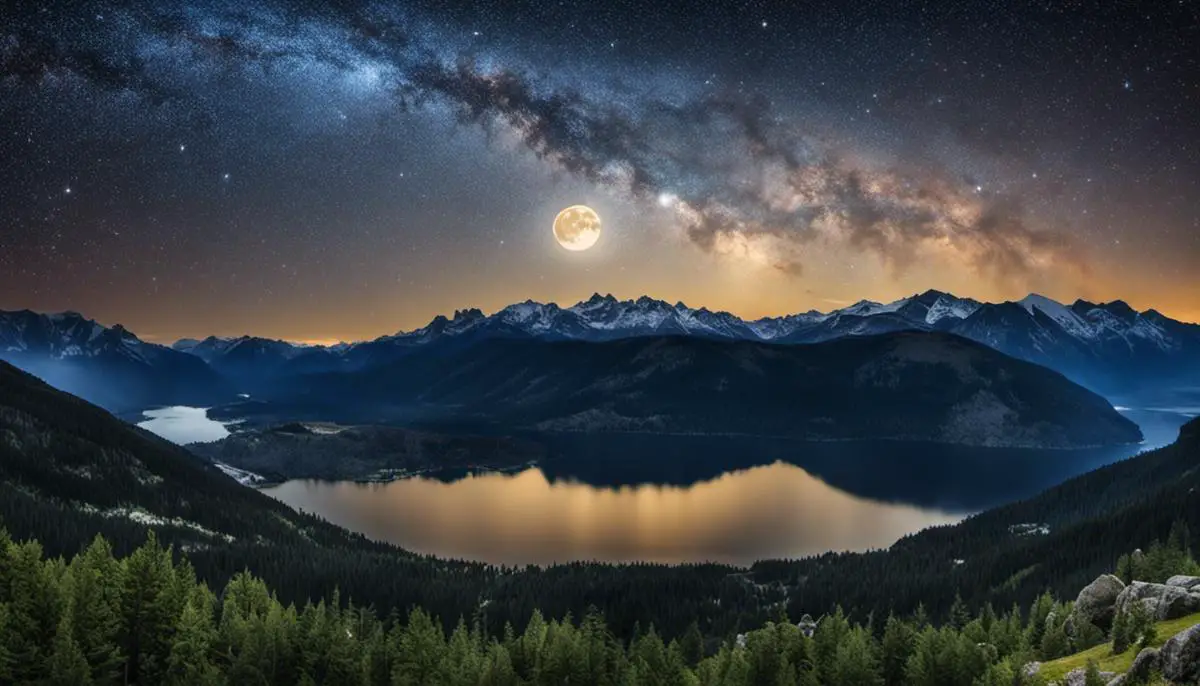The enchanting allure of a full moon has captivated humanity for centuries. Its ethereal silver glow illuminating the night skies paints a picture as old as time itself, yet intriguingly mysterious. This natural phenomenon, an astronomical spectacle, dances to the rhythm of patterns and cycles, embedded within the vast cosmic ballet. This tale begins with a comprehensive overview of what full moons represent, the science behind their occurrence, and the role they’ve played throughout history – in ancient and modern narratives alike. Transitioning from the general to the specific, the journey proceeds through the celestial corridors of September 2023, embracing the uniqueness of the full moon scheduled for this period. Entwining the cornerstones of astronomy, practical viewing guidelines, and the purported impacts of full moons on humans and nature, the exploration is set to transcend the boundaries of knowledge and imagination.
Background of Full Moons
Understanding Full Moons
Full moons occur approximately once a month when the moon is positioned directly opposite the sun, with the earth situated between them. During this time, the moon appears fully illuminated when viewed from earth, hence the term “full moon.” This lunar phase is the culmination of the moon’s waxing, when the previously visible portion of the moon gradually expands until it reaches the full moon stage.
The primary driving force behind these lunar phases is the moon’s orbit around the earth. A complete orbit takes about 27.3 days, but due to the earth’s simultaneous orbit around the sun, the lunar cycle—new moon to new moon—is approximately 29.5 days. This is known as a synodic month.
Significance of Full Moons Through the Ages
In ancient times, societies relied heavily on the lunar calendar for their survival. The phases of the moon were integral to agriculture, hunting, and even warfare. Full moons were especially important, often symbolizing abundance and fertility. Many ancient cultures developed myths and lunar deities, further underscoring the significance of the moon in early societies.
In modern times, while we no longer rely on lunar phases for survival, culturally and spiritually, full moons continue to carry considerable significance. Many calendars, including the Jewish and Islamic ones, still operate on lunar cycles. Additionally, in astrology, full moons symbolize culmination and fruition, often viewed as times of revelation, realization, and completion.
Significance of Moon Cycles
The patterns and cycles of the moon, including full moons, have also been of great interest to modern science. The moon’s gravitational pull influences the earth’s tides, creating the ebb and flow of oceans. Further research suggests that these cycles may even have subtle effects on weather patterns, wildlife behavior, and possibly human psychology.
Harvest Moon: September 2023
In September 2023, the full moon presents not only an astronomical phenomenon but also a seasonal landmark, synchronizing with the Autumnal Equinox in the Northern Hemisphere. This period is when the sun traverses the celestial equator moving towards the south, signifying the commencement of the fall season. This particular full moon, known as the Harvest Moon, has carried great historical significance. It was of pivotal importance to farmers as it cast additional illumination to assist in the harvest of their crops. Even in present day, it is still celebrated across diverse cultures; being recognized as an emblem of prosperity, transformation, and life transitions.

Specifics about September 2023 Full Moon
September 2023’s Harvest Moon: When to See?
The Harvest Moon in September 2023 is set to rise on the 8th at exactly 11:25 UTC (Coordinated Universal Time). For those in time zones like Eastern Daylight Time (EDT), this corresponds to 7:25 AM.
Visible Regions for the Full Moon
As full moons are a globally observable celestial event, barring any atmospheric obstructions, the September 2023 full moon will be visible everywhere around the world. The best views are generally had after moonrise when the moon is just over the horizon. In North America, moonrise on September 8th will be in the late afternoon or early evening.
Coinciding Celestial Events
In relation to other celestial events, the Full Moon for September 2023 will not coincide closely with any major meteor showers or eclipses. However, Casual observers with an eye to the sky may note the moon’s close proximity to the planet Neptune. On the day of the full moon, Neptune will appear very close to the moon — just a finger-width to the south, making for a unique viewing opportunity.
The September Full Moon is also traditionally known as the “Harvest Moon” or “Corn Moon” depending on Native American tribal customs, referring to this time as the period for harvest. Astronomically, it does not differ from any other full moon, but culturally and historically, it carries significance.
The moon’s phase, aside from the time of the full moon, advances by roughly one lunar phase per week. Additionally, changes in the moon’s appearance from night to night are subtle and generally observable from one evening to the next.
Lunar Brilliance and Brightness
September’s Full Moon is known for its particular brightness. Due to the moon’s elliptical orbit, the distance to the moon does vary over the course of the month and can impact how bright the full moon appears. For September 2023, the moon will be around its average distance from Earth resulting in a typical full moon brilliance. The brightness can also be affected by local weather conditions and atmospheric clarity, so a clear night will result in the best viewing.
Moon’s Impact on Tides
Around the time of any full moon, high tides on Earth will be at their highest for the month, and this is especially true for the September 2023 full moon. The gravitational pull from the sun and moon combine to create spring tides, which result in higher than average tides. Be advised this can have possible implications for coastal regions.
Set to illuminate the sky irrespective of the viewer’s geographic location, the Full Moon of September 2023 holds the anticipation of a stunning visual experience.

Astronomical Details
Nature’s Drama: The Synodic Cycle and Full Moon
Falling on the 6th, the September 2023 Full Moon, also known as the Harvest Moon, signifies the conclusion of the moon’s synodic cycle. In this phase, the sun and the moon find themselves diametrically opposite each other, as observed from Earth. This arrangement facilitates the full moon’s omnipresence in the night sky and thus, amplifies its visibility, making it one of the most highlighted lunar events of the month.
Distance from Earth: Moon’s Apogee and Perigee
The moon’s orbit around the Earth is not perfectly circular but elliptical, causing its distance to vary. On average, the moon is about 238,855 miles away from Earth. In September 2023, the moon will be at apogee (its farthest point from Earth) on the 14th, approximately 252,622 miles away. Conversely, the moon reaches its perigee (closest point to Earth) on the 29th of the month, at roughly 227,957 miles away.
Illumination: Moon’s Reflective Brightness
The percentage of the moon’s surface illuminated by the sun changes throughout its various phases. During the full moon of September 2023, the illumination is expected to reach 100%, providing optimal conditions to view the celestial event. The incredible illumination makes the moon appear brighter in the night sky.
Tracking the Moon’s Trajectory in the Sky
The moon’s trajectory during its full phase varies based on the location of the observer on the Earth. Generally speaking, if you are observing from the Northern Hemisphere, you can expect to find the full moon glowing in the southern sky. Particularly for September 2023, the full moon is forecasted to be in the constellation of Pisces. As a result of Earth’s rotation, it would appear to traverse from east to west in the southern hemisphere of the sky.

Observation Tips
Choosing an Ideal Location for Moon viewing
As the full moon unveils itself in September 2023, the importance of being in an optimum location to fully embrace its unadulterated beauty cannot be overstated. Setting up observation in urban areas might lead to a diminished viewing experience due to the prevalent light pollution. On the other hand, rural areas with low light pollution tend to offer a much more gratifying view of the moon. Additionally, sites that are elevated, like hills or rooftop decks, can provide a clear, unhampered view of the celestial spectacle.
Considering Timing for Best Observation
As for the timing, it’s important to note that the full moon rises in the east around sunset and sets in the west around sunrise. For the full moon of September 2023, the timing will depend on your specific location. In general, the clearest view of the full moon is when it is nearest to the zenith (the point in the sky directly above you), which is typically late in the evening. Utilize an online moon phase calendar or a mobile astronomy application to track the moon’s rising and setting times for your area.
Appropriate Equipment for Enhanced Viewing
Having the correct equipment can greatly enhance your moon viewing experience. A pair of binoculars is a good start as they can provide detailed views of the moon’s surface. For avid sky-gazers, a telescope may be a worthwhile investment. Look for one that offers high-magnification views, as this will enable you to see craters and other lunar features in greater detail. Remember, safety is paramount when observing celestial bodies; never look directly at the sun with binoculars or a telescope as it can cause severe eye damage.
The Importance of Weather & Light Pollution
Your viewing experience will be highly dependent on the weather and light pollution. Clear, dry nights with few clouds are optimal to view the full moon. Light pollution, which is excessive or inappropriate artificial light, can greatly interfere with astronomical observation. Therefore, it’s advised to escape the city lights and head to darker, rural areas for the best viewing experience. For your convenience, there are various online resources and apps, like the ‘Light Pollution Map,’ that can assist in finding the darkest skies near you.
How to Prepare for the Full Moon September 2023
In anticipation of the upcoming full moon viewing in September 2023, you can take several steps to ensure that your experience is exceptional. Begin by checking the local weather forecast to adequately plan your viewing. You might want to set up a reminder for the optimum viewing time, and make sure you have your viewing equipment ready in advance. Dress suitably for the outdoor weather and don’t forget to bring along insect repellent if necessary, to ensure your viewing experience is as comfortable as possible.

Full Moon Impact on Humans and Nature
The Full Moon and Its Influence on Human Behavior
Historically, many have alleged the full moon to have an effect on human behavior and emotions. Stories from various cultures and eras have shared tales of increasingly erratic or tumultuous behavior during this lunar phase, contributing to widespread beliefs in lunar lunacy and instigating countless myths and legends. Despite these narratives, extensive scientific research over the past three decades has discredited these theories, revealing no significant association between the full moon’s occurrence and behavioral disruptions, substance abuse, or crime rates.
Interestingly, though, is the seeming correlation between the lunar full moon and human sleep patterns. Some sleep studies have suggested that individuals tend to experience disturbed sleep or difficulty falling asleep during a full moon. This phenomenon could potentially be explained by the sleeping patterns of our ancestors – the moonlight’s brightness during a full moon might have interfered with their sleep, and it’s feasible that these patterns could be embedded within us.
Effects on the Tides
The full moon directly affects the tides because the moon and sun’s gravitational forces are aligned, creating higher than average tides known as spring tides. In September 2023, the full moon will occur on September 8th, meaning the strongest spring tides (also known as perigean spring tides) will likely occur around that time. The National Oceanic and Atmospheric Administration (NOAA) continually monitors these tides due to their possible implications on coastal flooding.
Impact on Wildlife
Animal behavior may also be influenced by the full moon. Many species have evolved to take advantage of the extra moonlight during this phase. For instance, some birds use the moonlight to navigate during migration, and predators like lions have been observed hunting more efficiently under the light of the full moon. On the other hand, prey species like some rodents become less active during full moon nights to avoid these predators.
Marine life is also influenced by the full moon; coral species use lunar cycles to synchronize spawning events, creating incredible underwater displays. In 2023, expect to see noticeable changes in animal behaviors around the time of the full moon in September.
While the full moon undoubtedly has observable effects on nature, its impact on human behavior and emotions remains mostly folklore. Regardless, the full moon continues to captivate us due to its luminescent beauty and the rhythm it imparts to the natural world. So, enjoy the full moon of September 2023, as you think about the rhythmic lunar pulse that helps regulate the natural world.

Fervently appealing to both scientific curiosity and rumors of lunar influence on life on Earth, the full moon of September 2023 presents a multidimensional perspective encompassing astronomy, folklore, and personal experience. Its charm lies not simply in the astronomical details of its phase and location in the sky nor solely in the practicalities of viewing it, but also in the more subjective realms of human emotions and natural wonders, like tides and wildlife behavior. These fascinating intersections point to our enduring relationship with the moon, a beacon glowing in our night sky, continually inspiring wonder and reflection upon our place in the grand cosmic theater. With understanding comes appreciation, and with appreciation, an even deeper sense of connection to our majestic universe and the spectacular phenomenon that is the full moon.
FAQ
Is there a full moon in September 2023?
Yes, in September 2023, there will be a full moon. The September 2023 full moon is commonly referred to as the “Harvest Moon” due to its proximity to the autumnal equinox, which normally occurs in late September. The Harvest Moon, which is often connected to the fall season, is renowned for its strong and lengthy illumination, which has historically helped farmers continue harvesting into the night. Those who enjoy watching the change of the seasons and skywatching look forward to this important optical phenomenon.
What is the most beautiful moon in 2023?
The subjective nature of moon beauty might differ based on personal preferences and cultural viewpoints. There will be multiple full moons in 2023, each with special characteristics and allure. Many find the full moons that coincide with seasonal transitions to be especially magical, however it’s difficult to declare one full moon to be the “most beautiful” in a given year. For example, people celebrate the September Harvest Moon because of its bright appearance and connection to the fall equinox. In a similar vein, people frequently appreciate the calm, wintry atmosphere of the December Cold Moon. The moon’s beauty is ultimately a matter of personal perspective, shaped as it is by cultural and emotional ties to celestial events.
What will the moon phase be in September 2023?
September 2023 will have a new moon, which will proceed through its phases to a full moon, in accordance with the regular lunar cycle. The exact dates of September 2023’s moon phases will vary, but in general, the cycle will start with a new moon at the beginning of the month and end with a full moon, also known as the Harvest Moon, towards the end of the month. Other phases of the moon will include a waxing crescent, first quarter, and waxing gibbous. Following the full moon, the moon moves closer to the next new moon, which usually happens in early October, and goes through its waning gibbous, third quarter, and waning crescent phases. For ages, people have been observing and tracking these moon phases, which are an essential part of the lunar calendar and other astronomical events.
What is the unique moon in 2023?
Astronomers and skywatchers alike are excitedly awaiting a singular celestial occurrence in 2023: the coming together of multiple uncommon lunar events, which are combined to form the “Unique Moon.” There are a number of fascinating events that will define this incredible lunar experience. The most notable event is the “Supermoon,” which occurs when the Moon appears larger and brighter in the night sky as it approaches Earth on its elliptical orbit. This Supermoon will also fall on the same day as a “Blood Moon,” which is a total lunar eclipse in which sunlight is scattered over Earth’s atmosphere, giving the Moon a dramatic scarlet tint. Predicted to enhance the show, a “Blue Moon”—the second full moon in a calendar month—is anticipated. For stargazers worldwide, the conjunction of a Supermoon, Blood Moon, and Blue Moon in 2023 is sure to create a once-in-a-lifetime lunar event.
What is the largest full moon in 2023?
Skygazers and lovers of the moon will be treated to a celestial show in 2023 when the biggest full moon of the year appears in the night sky. Known as a “Supermoon,” this phenomena happens when the Moon is at its closest to Earth during its full phase due to its elliptical orbit. Because of this, the Supermoon seems much bigger and brighter than a typical full moon, providing viewers with an amazing and mind-blowing spectacle. This event’s precise timing may change, but whenever it happens, it will surely catch the attention of photographers and stargazers alike and serve as a constant reminder of the universe’s ever-changing, yet infinitely fascinating, splendor.
![]()
